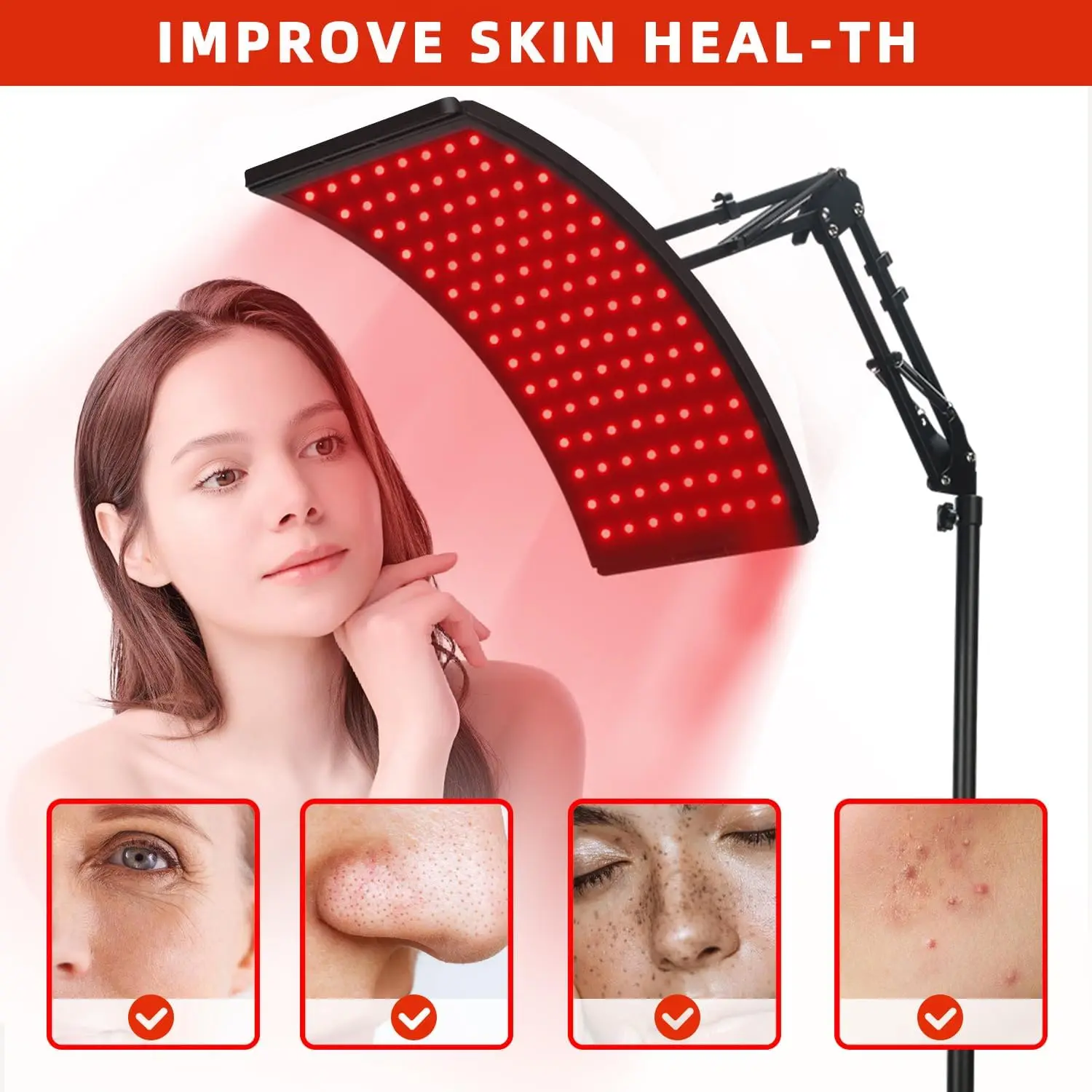Red Light Therapy for face& skin

Red light therapy (RLT) is an innovative treatment that harnesses specific wavelengths of light to promote healing and improve various skin and body conditions. Mainly utilizing the wavelengths of red light, particularly those around 660 nanometers (nm), this therapy penetrates the skin and stimulates cellular function, making it a promising option for rejuvenation and wellness. RLT not only addresses skin-related issues but also enhances overall well-being.
The science behind red light therapy lies in its ability to energize mitochondria, which are the cellular powerhouses responsible for producing adenosine triphosphate (ATP). The increase in ATP availability promotes faster cellular repair, regeneration, and enhanced blood circulation. As a result, the skin can repair itself more effectively, mitigating the visible signs of aging like fine lines, wrinkles, and uneven skin tone.
Furthermore, red light therapy has been linked to various beneficial outcomes. For instance, it bolsters collagen production, a protein crucial for maintaining skin elasticity and firmness. This is especially relevant for individuals keen on reversing the signs of aging. Additionally, its anti-inflammatory properties make it suitable for treating conditions like acne, psoriasis, and eczema.
The growing popularity of RLT can be attributed to its versatility and effectiveness. It is widely used in clinical settings, such as dermatology and physical therapy clinics, where trained professionals administer treatments for specific ailments. However, the advent of user-friendly handheld devices and full-body panels has made red light therapy accessible for home use, increasing its appeal to a broader audience.
In summary, red light therapy represents a synthesis of ancient healing wisdom and modern scientific research. With its well-documented effects on cellular health and skin rejuvenation, RLT is an increasingly favored approach for those seeking a non-invasive method to enhance their skin’s appearance and overall body health.
Benefits of Red Light Therapy for Skin
Red light therapy has emerged as a popular option for enhancing skin health and appearance. This therapeutic approach utilizes low-level wavelengths of light that penetrate the skin, stimulating cellular processes and improving overall skin texture and tone. One of the primary benefits of red light therapy is its ability to reduce fine lines and wrinkles, making it an effective anti-aging treatment. Studies have shown that skin exposed to red light demonstrates increased collagen production, which is essential for maintaining skin elasticity and reducing the signs of aging.
Moreover, red light therapy plays a significant role in accelerating wound healing. The stimulation of collagen and elastin production not only aids in skin regeneration but also helps in minimizing scarring. This therapy has been beneficial for individuals recovering from surgical procedures or those with chronic wounds. Clinical studies indicate that patients subjected to red light therapy experienced significantly faster healing times, which showcases its effectiveness in dermatological recovery processes.
In addition to rejuvenating aging skin, red light therapy has also proven effective in treating various skin conditions such as acne and rosacea. By reducing inflammation and promoting healing at a cellular level, it helps in minimizing breakouts and soothing irritated skin. Numerous testimonials from users indicate positive outcomes, with many reporting noticeable improvements in their skin condition following regular treatments.
Robust clinical evidence supports these claims, with research groups noting substantial improvements in skin quality among participants utilizing red light therapy. The combination of anecdotal experiences and scientific validation positions red light therapy as a promising option for individuals seeking to enhance their skin health, making it a valuable addition to skincare routines. Overall, its multifaceted benefits highlight the versatile applications of this innovative therapy.
Utilizing Red Infrared Light Therapy Lamps at Home
Red infrared light therapy has gained popularity for its potential to improve skin health and promote healing. When considering the use of a red infrared light therapy lamp at home, it is crucial to choose the right device that meets your personal health goals. Lamps that utilize 660nm LED technology are particularly effective, as this wavelength is known to penetrate the skin efficiently, activating cellular functions and enhancing the therapy experience.
When selecting a red light therapy lamp, look for devices that offer adjustable intensity settings, a sturdy stand for optimal positioning, and a user-friendly control panel. The presence of a timer feature can also help in managing treatment sessions effectively. Some lamps are designed specifically for facial treatments, while others provide broader coverage for the body, so consider your area of focus when making your selection.
Optimal usage times can vary based on individual needs; however, most users find benefit in sessions lasting between 10 to 20 minutes. It is advisable to use the lamp at least three times a week for the best results. Positioning is fundamental in ensuring that the light reaches the target area effectively; maintain a distance of 6 to 12 inches between the lamp and the skin for adequate exposure without causing discomfort.
Safety precautions should not be overlooked during treatment. Always start with shorter sessions to gauge your skin’s reaction to the therapy, and avoid direct eye exposure unless using eyewear specifically designed for light therapy. Additionally, it is important to consult with a healthcare professional if you have underlying skin conditions or are pregnant, as individual circumstances may alter the advisable use of red infrared light therapy at home.
Potential Side Effects and Considerations
While red light therapy is widely regarded for its numerous benefits, it is essential to acknowledge that, like any treatment, it may not be suitable for everyone. Some individuals may experience skin reactions, including redness, irritation, or a temporary increase in sensitivity following treatment. These responses are generally mild and subside shortly after the session. However, those with pre-existing skin conditions such as eczema or psoriasis should exercise caution when utilizing red light therapy, as it may exacerbate their condition. It is advisable for these individuals to conduct a patch test before committing to full treatment.
Moreover, individuals with light sensitivity or those taking medications that increase photosensitivity must avoid red light therapy or consult their healthcare providers before initiating treatment. Certain medications, such as antibiotics or diuretics, can cause adverse reactions when exposed to light therapies, making it crucial to disclose all medications to the treating practitioner.
For individuals with specific health conditions such as cancer, seizure disorders, or pregnancy, it is particularly important to engage in discussions with healthcare professionals prior to commencing red light therapy. Such consultations can help tailor treatment plans that consider the individual’s medical history, ensuring safe integration and minimizing risks.
Incorporating red light therapy into a broader wellness routine can yield the best results for one’s health and beauty goals. Individuals are encouraged to start gradually and monitor their body’s responses, adjusting the frequency and duration of treatments accordingly. Consulting with professionals in both dermatology and holistic health may provide a more comprehensive understanding of how red light therapy can be safely utilized as part of an overall wellness strategy.
